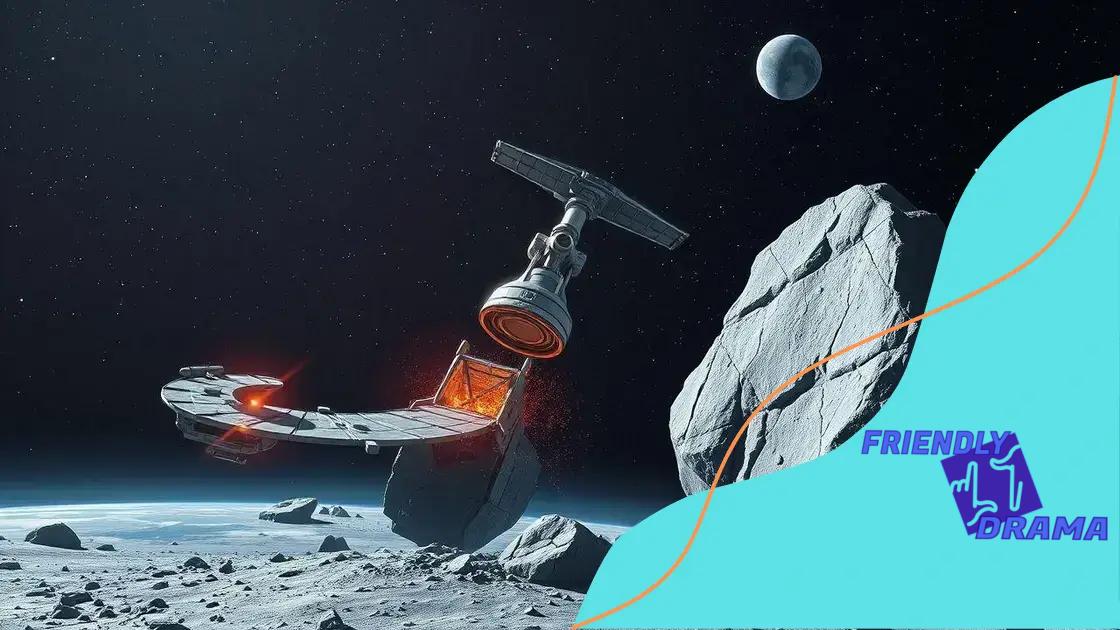The potential of space mining for global resources

Anúncios
The potential of space mining involves extracting valuable resources like precious metals and water from celestial bodies, presenting both opportunities for technological advancement and challenges such as legal and environmental concerns.
The potential of space mining for global resources is a fascinating concept that might reshape our understanding of resource availability. What if the next gold rush happens in outer space? This article dives into the possibilities and implications of space mining.
What is space mining?
Space mining refers to the extraction of valuable minerals and resources from celestial bodies, like asteroids and the Moon. This innovative concept could revolutionize our approach to resource availability on Earth.
Anúncios
By targeting these rich resources in space, we could uncover numerous materials that are rare on our planet. Some examples include precious metals like gold and platinum and essential resources like water and helium-3.
Key Resources in Space Mining
Space mining has the potential to provide several key materials:
- Water: Essential for sustaining life and creating rocket fuel.
- Precious Metals: Gold and platinum, found in asteroids, can be extremely valuable.
- Helium-3: A potential fuel source for nuclear fusion, which could power future energy needs.
These resources present exciting opportunities, but the technology required for extraction needs to be developed further. Current advancements in robotics and AI pave the way for these missions.
Anúncios
Additionally, the benefits of space mining extend beyond material gain. This endeavor can drive technological innovations that improve life on Earth. For example, developing systems for extracting resources in microgravity could lead to new engineering techniques that benefit various industries.
Challenges in Space Mining
Despite the potential, there are obstacles to overcome. Space mining requires significant investment and the development of safe and efficient extraction technologies.
- High Costs: Initial missions will be expensive, requiring substantial funding and international cooperation.
- Technological Hurdles: Developing reliable equipment for extreme conditions in space is crucial.
- Legal and Ethical Issues: Outlining policies for ownership of space resources is necessary to avoid conflicts.
Overall, the pursuit of space mining holds immense promise for our future. It could reshape how we understand resources and encourage the advancement of technology.
Key resources available in space
The universe is filled with key resources that could change our future. Many celestial bodies, especially asteroids and the Moon, contain materials that could significantly benefit Earth. Understanding what these resources are is essential for the advancement of space mining.
Asteroids are often referred to as treasure chests of minerals. They host various invaluable resources that we can extract and use. Some of these resources include precious metals, water, and rare materials.
Types of Resources
Here are some of the critical resources found in space:
- Water: Water is essential for supporting life and can also be converted into fuel for spacecraft.
- Precious Metals: Many asteroids are rich in metals such as gold, platinum, and nickel, valuable for technology and jewelry.
- Helium-3: This isotope can be used in nuclear fusion, providing a clean and powerful energy source for the future.
- Rare Earth Elements: These are crucial for electronics and renewable energy technologies.
In addition to these materials, moons like Europa and Enceladus may have subsurface oceans, offering further exploration potential. These resources can help address Earth’s growing needs and reduce the depletion of our planet’s resources.
As technology advances, the ability to access and utilize these materials becomes more feasible. The mining of space resources could not only meet our demand back on Earth but also facilitate deeper space exploration.
The technology behind space mining

The technology behind space mining is rapidly evolving. Various tools and systems are being developed to access resources in space efficiently. These technologies aim to make mining operations possible beyond Earth’s boundaries.
One of the critical technologies in space mining is robotics. Spacecraft equipped with advanced robotic arms can perform tasks with precision. These robots are designed to handle materials found in hostile environments, such as asteroids.
Key Technologies in Space Mining
Several key technologies are driving the future of space mining:
- Autonomous Robots: Robots that can operate independently in space, conducting mining operations without human intervention.
- 3D Printing: This technology allows creating tools and components directly in space, reducing the need to transport everything from Earth.
- Satellite Communication: Effective communication systems are crucial for coordinating mining efforts and ensuring safety.
- Resource Identification Software: Advanced software helps identify resource-rich areas on asteroids and other celestial bodies.
Another crucial aspect of technology in space mining is the propulsion systems used to reach these distant locations. Efficient propulsion technologies, such as ion thrusters, enable spacecraft to travel further with less fuel. This makes missions to resource-rich areas more feasible.
Innovations in materials science also play a role. Developing materials that can withstand the harsh conditions of space is essential for mining equipment and spacecraft. These materials need to endure extreme temperatures, radiation, and micrometeorite impacts.
As these technologies progress, the idea of space mining becomes more realistic. The combination of robotics, propulsion, and materials science will pave the way for efficient resource extraction in our solar system.
Environmental impact of space mining
The environmental impact of space mining is an important topic to consider as we explore resource extraction beyond Earth. While the idea of mining asteroids and moons offers many opportunities, it also raises significant questions about its ecological effects.
One of the primary concerns is how space mining could alter celestial bodies. Extracting minerals from asteroids may change their orbits or create debris in space, potentially impacting other spacecraft and natural satellites. Careful assessment of these risks is essential.
Potential Environmental Effects
Several environmental impacts must be evaluated:
- Disruption of Celestial Bodies: Mining operations can lead to changes in the structure and surface of asteroids.
- Space Debris: Mining could generate debris that poses a risk to satellites and spacecraft.
- Resource Allocation: If not managed well, mining could lead to unfair access to resources, raising ethical issues.
In addition to the impacts on space itself, there are concerns about how these activities might influence Earth’s environment. If raw materials are brought back to Earth, the processes used to refine and utilize these materials may result in pollution and resource use that mirror current environmental challenges.
Moreover, the potential for large-scale operations in space can lead to increased resource competition among nations and private companies, prompting discussions on regulation and shared responsibilities.
As technology advances, it’s vital to develop sustainable practices that mitigate these environmental impacts. Creating guidelines for space mining can ensure responsible exploration and utilization of extraterrestrial resources.
Future prospects and challenges
The future prospects of space mining are bright, but many challenges lie ahead. As technology continues to improve and we better understand the resources available in space, the potential benefits of mining celestial bodies appear promising.
One major prospect is the possibility of significantly increasing the supply of rare materials. As Earth’s resources become depleted, turning to asteroids and other celestial bodies can provide essential minerals and materials needed for various industries.
Emerging Opportunities
There are several key opportunities in the field of space mining:
- Economic Growth: Space mining could lead to new industries, creating jobs and stimulating economic growth both on Earth and in space.
- Technological Advancements: The development of mining technologies may benefit other fields, such as robotics and materials science.
- Resource Sustainability: By using resources from space, we can reduce the ecological burden on Earth and ensure a steady supply for future generations.
However, these opportunities come with significant challenges that need to be addressed. Managing the costs associated with missions is a primary concern. Developing the technology to extract resources from space is expensive and requires significant investment.
Another challenge is addressing the legal and ethical implications of space mining. As nations and private companies race to stake their claims, international regulations must evolve to ensure fair access and sustainability. Questions of ownership and resource allocation will need to be resolved to prevent conflicts.
The environmental impact of space mining also requires careful consideration. We must ensure that operations do not harm celestial bodies or create debris that could endanger other missions.
In summary, the future of space mining holds immense promise, yet it is crucial to navigate its challenges thoughtfully. With proper planning and collaboration, we can maximize the benefits while minimizing risks.
In summary, the potential of space mining offers exciting opportunities for the future. By tapping into resources found on asteroids and other celestial bodies, we could address Earth’s growing demands while reducing environmental impact. However, numerous challenges need careful attention, including technological, legal, and ecological considerations. Collaboration and innovation will be key in ensuring that space mining benefits humanity without harming the cosmos.
FAQ – Frequently Asked Questions about Space Mining
What are the main resources that can be mined in space?
Asteroids and other celestial bodies can provide precious metals, water, and important elements like helium-3.
How does space mining impact Earth’s environment?
If managed poorly, space mining can create space debris and disrupt celestial bodies, leading to potential ecological concerns.
What technologies are needed for effective space mining?
Key technologies include autonomous robots, 3D printing for tools, and advanced propulsion systems to reach mining sites.
What challenges does space mining face?
Challenges include high costs, legal issues regarding resource ownership, and ensuring the environmental sustainability of operations.





